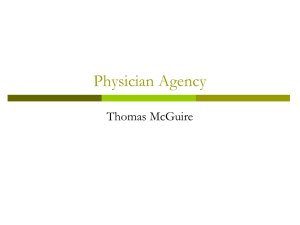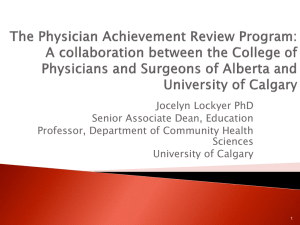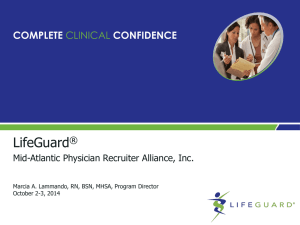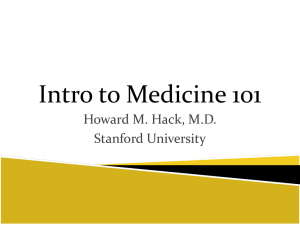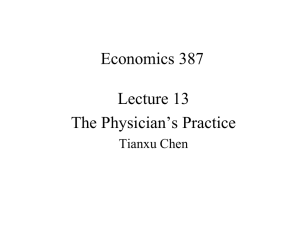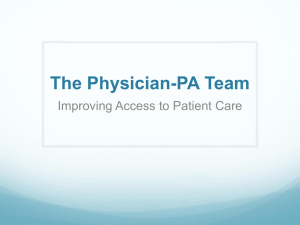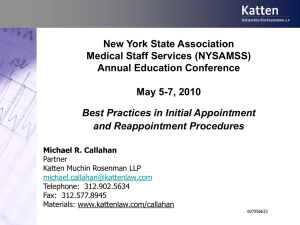The Physicians
advertisement
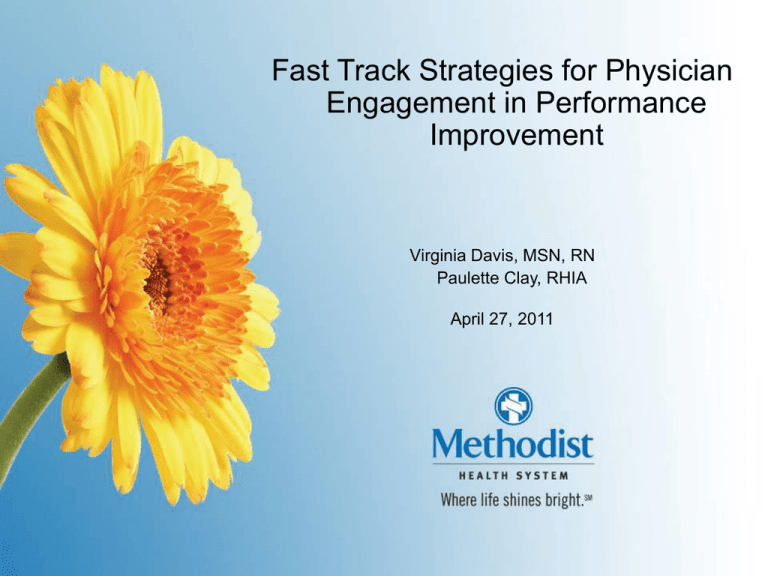
Fast Track Strategies for Physician Engagement in Performance Improvement Virginia Davis, MSN, RN Paulette Clay, RHIA April 27, 2011 1 OBJECTIVES • List three tools to rapidly gain physician engagement with performance improvement initiatives • Define the role of physician leaders in clinical performance improvement initiatives • List three benefits to physicians of participation in performance improvement initiatives 2 Telling the Story • From the physician’s perspective – Why participate? – What are the benefits? – What resources were needed for physicians to effectively participate? – What were the results? 3 Performance Improvement The Pre-work – Identify the “need” – Identify the key stakeholders – Data aggregation – Prioritize improvements – Outline the “methodology” – Define the roles of staff, physicians, others 4 Performance Improvement • Performance refers to the way people do their jobs and the results of their work • PI utilizes a systematic methodology to find the root causes of a performance problem and correct the specific performance deficit • PI activities should be datadriven and evidence-base PI measures the functioning of important processes, services and identifying changes that enhance performance PI focuses on outcomes of care, treatment and services PI reduces factors that contribute to unanticipated adverse events and/or outcomes “To the person who only has a hammer in the toolkit, every problem looks like a nail.” Abraham Maslow 5 Identify the “Need” and the “Key Stakeholders” Need What “needs” to be addressed What “needs” to be the desired outcome/expectation What “needs” to be the next steps in the process Key Stakeholders Stakeholders may or may not be integral to the project Those from whom requirements will be drawn, Those who will influence the success of the project Those who will be impacted by the project/new design Those who will benefit from project success • • • 6 Know who influences the stakeholders and who the stakeholders influence Know what the stakeholders value (time, financials, ease of practice, recognition, reputation, etc.) Stakeholder involvement in and knowledge of project builds confidence and acceptance Define the opportunity AND the project • Define desired performance, goal, target • Define the project purpose and scope • Define performance gaps between desired and actual performance • Find root causes of performance gaps • Prioritize (the root causes) for action – Impact – small, major – Resources required – minimum, significant (personnel, costs, IT) – Time to address – short term, long term • Select and design interventions • Implement interventions • Monitor and evaluate performance 7 Data Aggregation – Aggregate data result from combining data elements from multiple time frames or over a period of time, from a variety of sources, reflect a variety of sub-populations, provide information regarding multiple providers and/or sites (e.g. process results, outcomes, costs, impact of improvements) – The data should tell a story – e.g. hospital performance compared to national data base, individual physician performance compared to other internal medical staff performance – The aggregate data are usually presented collectively or in summary form – Aggregated data should provide information expressed in a summary form for purposes of reporting, analysis, action 8 Prioritizing Actions/ Achieve the Goal Assess the situation – Review historical information – Document current status – Trend/Process analysis Define a realistic vision – Brainstorm ideas for improvement – Group related improvement ideas – Identify areas that are working well – Evaluate and prioritize potential initiatives and existing services 9 Prioritizing Actions/ Achieve the Goal Plan to reach the vision – Timeline – Measurable objectives – Commitment & Communication of plan Implement, Evaluate, Update – Obtain the necessary resources – Implement the operational plans – Evaluate performance measures – Update plan 10 Performance Improvement 11 Objectives: Fast Track Methods for Physician Engagement in Performance Improvement – List three tools to rapidly gain physician engagement with performance improvement initiatives – Define the role of Physician Leaders in Clinical Performance Improvement Initiatives – List three benefits to physicians of participation in performance improvement initiatives 12 Fast Track Methods for Physician Engagement 6. Adopt an Engaging Style 1. Discover Common Purpose Engaging Physicians 2. Reframe Values and Beliefs 5. Show courage 3. Segment the Engagement Plan 4. Use “engaging” PI plan 13 Reinertsen JL, Gosfield AG, Ripp W, Whittington JW. Engaging Physicians in a Shared Quality Agenda. Engaged Physicians • Physician Roles in Performance Improvement – Champion – advocate, defender, challenger, respected – Mentor – trusted counselor, guide, coach – Supporter – adherent • ENGAGED – attracted by influence or power, to mesh, to bind 14 Champions/Engaged LeadersCommon Purpose – Understanding the “stakeholders” – • The Physicians’ “World View” • Physician practice environment and life – Physician leadership development – Physician benefits – • WIIFM (What’s in it for me?) 15 The Physicians’ “World View”Common Purpose? – Primary focus – • • • • Own business Own practice Want what is best for their patients TIME – Responsible for care provided patients – • Focus is on own performance……related to patients • Autonomy vs. system view • (“If I work hard enough/study hard enough, I won’t make mistakes”) – Within hospitals – • Organized Medical Staff • Voluntary • Contract – Faculty, Medical Director, Services such as “hospitalists”, anesthesiologists, radiologists, etc. – “Administration as a partner” is desirable 16 Physician Leadership Development – Reframing – Medical Staff Institute – Off-site training – On-line training – Board education and participation – Succession and Leadership planning 17 Physician Benefits WIIFM (What’s in it for me?) –Improved patient outcomes –Reduce hassles and wasted time –Make the “right thing” easy to do –Feedback re personal performance 18 Communicating the Need and the Benefit – Segment the Plan • TOOLS of the trade – Use data and evidence as a catalyst – Use of a Performance Improvement Team Charter – Know the “Beauty” of a Work plan – Tell the Story 19 Telling the Story • From the physician’s perspective – Why participate? – What are the benefits? – What resources were needed for physicians to effectively participate? – What were the results? 20 Need and Data – VTE prophylaxis – VAP prevention – Use of Rapid Response Team 21 Need and Data – VTE Prophylaxis • Comparative Data • Physician Champion • Ongoing data – VAP Prevention • • • • Comparative Data and Rates Proven bundles Desire for different practice of Respiratory Therapists Champion – Use of Rapid Response Team • • • • 22 Comparative Data Published impact Defined interventions Advisory Role Performance Improvement Engagement – Use an “engaging” PI Plan – Data • Comparative • External benchmarks – Champion – and other influential leaders – Charter • • • • • • • 23 Purpose/Goal Objectives/Deliverables Members Time Frames Key Measures Reporting to/Direction from - Structure Sponsorship and other resources Performance Improvement Engagement – Use an “engaging” PI Plan Work plan • Number of meetings • Pre-planned agenda and data requirements for each • Notices • Expectations for all • Accountability a pre-requisite • Key measures, data collection/reporting, RESULTS 24 Telling the Story • Reduction of VTEs • Comparative data • System-wide • Ongoing updates – recognition • Prevention of VAPs • Monthly reports • Champion speaking • Transition/commitment story • Use of Rapid Response Team • Ongoing reports – Medical Staff Quality Council, Quality Committee of the Board, Medical Staff Dept • Amount of time and impact on physicians 25 Telling the Story – “Straight from the physician’s mouth” - Engaging Style – Motivators – Benefits – Data/information as catalyst – Champion – function – Preparation for role – training, education, experiences – Staff support needed – Advice for recruitment and partnership 26 OBJECTIVES • List three tools to rapidly gain physician engagement with performance improvement initiatives • Define the role of physician leaders in clinical performance improvement initiatives • List three benefits to physicians of participation in performance improvement initiatives 27 References/Bibliography – Reinertsen JL, Gosfield AG, Ripp W, Whittington JW. Engaging Physicians in a Shared Quality Agenda. IHI Innovation Series white paper. Cambridge, Massachusetts: Institute for Healthcare Improvement; 2007 (Available on www.IHI.org) – Performance Improvement Stages, Steps and Tools. IntraHealth International/Prime II www.intrah.org/sst 2002 August – Pisek PE and Kilo CM. From Resistance to Attraction: A Different Approach to Change. Physician Executive 1999 Nov; 25(6): 40-44 – Guthrie M. Engaging Physicians in Performance Improvement. American Journal of Medical Quality 2005 Sep/Oct; 20(5): 235-238 – Bader BS. Time for a New Model for Hospital Physician Collaboration. www.GreatBoards.org 2002 August; 2(3): 1-3 28 29

